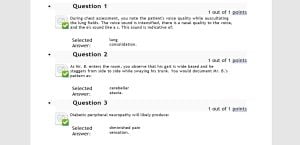COURSE
NURS 6512 Advanced Health Assessment and Diagnostic
- Question: During chest assessment, you note the patient’s voice quality while auscultating the lung fields. The voice sound is intensified, there is a nasal quality to the voice, and the e’s sound like a s. This sound is indicative of:
- Question: As Mr. B. enters the room, you observe that his gait is wide based and he staggers from side to side while swaying his trunk. You would document Mr. B.’s pattern as:
- Question: Diabetic peripheral neuropathy will likely produce:
- Question: Montgomery tubercles are most prominent in the breasts of:
- Question: Which one of the following techniques is used to detect a torn meniscus?
- Question: Ulnar deviation and boutonniere deformities are characteristic of:
- Question: A pulsation that is diminished to the point of being barely palpable would be graded as:
- Question: In the most effective percussion technique of the posterior lung fields, the patient cooperates by:
- Question: When palpating joints, crepitus may occur when:
- Question: While collecting personal and social history data from a woman complaining of breast discomfort, you should question her regarding:
- Question: Postural hypotension is defined as a _____ when the patient stands, compared with sitting or supine readings.
- Question: You are examining a patient in the emergency department who has recently sustained head trauma. In order to initially assess this patient’s neurologic status, you would:
- Question: Temporalis and masseter muscles are evaluated by:
- Question: A parent is advised to restrict contact or collision sports participation for their child. An example of a sport in which this child could participate is:
- Question: Cranial nerve XII may be assessed in an infant by:
- Question: The reliability of health-related findings and observations is the responsibility of the:
- Question: Normal changes of the aging brain include:
- Question: The adnexa of the uterus are composed of the:
- Question: For purposes of examination and communication of physical findings, the breast is divided into:
- Question: A patient in the deepest coma would be scored a _____ on the Glasgow Coma Scale.
- Question: A patient you are seeing in the emergency department for chest pain is suspected of having a myocardial infarction. During the health history interview of his family history, he relates that his father had died of “heart trouble.” The most important follow-up question you should pose is which of the following?
- Question: Nerves that arise from the brain rather than the spinal cord are called:
- Question: While examining a 30-year-old woman, you note that one breast is slightly larger than the other. In response to this finding, you should:
- Question: In the adult, the apical impulse should be most visible when the patient is in what position?
- Question: A 23-year-old white woman has come to the clinic because she has missed two menstrual periods. She states that her breasts have enlarged and that her nipples have turned a darker color. Your further response to this finding is to:
- Question: Tarry black stool should make you suspect:
- Question: To assess spinal levels L2, L3, and L4, which deep tendon reflex should be tested?
- Question: You are conducting an examination of Mr. Curtis’s heart and blood vessels and auscultate a grade III murmur. The intensity of this murmur is:
- Question: To assess a cremasteric reflex, the examiner strokes the:
- Question: An examiner has rotated a brush several times into the cervical os. The brush was withdrawn and stroked lightly on a glass slide. The slide was sprayed with fixative. Which type of specimen requires this technique for collection?
- Question: Functional assessment is most important during the examination of a(n):
- Question: Part of the screening orthopedic component of the examination includes evaluating the person while he or she is:
- Question: To spread the breast tissue evenly over the chest wall, you should ask the woman to lie supine with:
- Question: When is the mental status portion of the neurologic system examination performed?
- Question: If a patient cannot shrug the shoulders against resistance, which cranial nerve (CN) requires further evaluation?
- Question: One of the most important aspects to consider in the orthopedic screening examination is:
- Question: You are examining Mr. S., a 79-year-old diabetic man complaining of claudication. Which of the following physical findings is consistent with the diagnosis of arterial occlusion?
- Question: The Mini-Mental State Examination should be administered for the patient who:
- Question: If pitting edema is unilateral, you would suspect occlusion of a:…………………………………………..
ANSWERS

……………..Please click the icon below to purchase all exams answers at $18